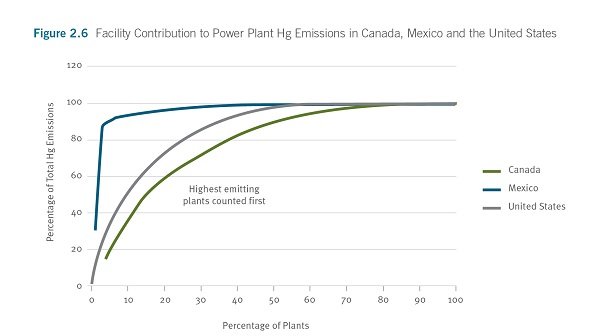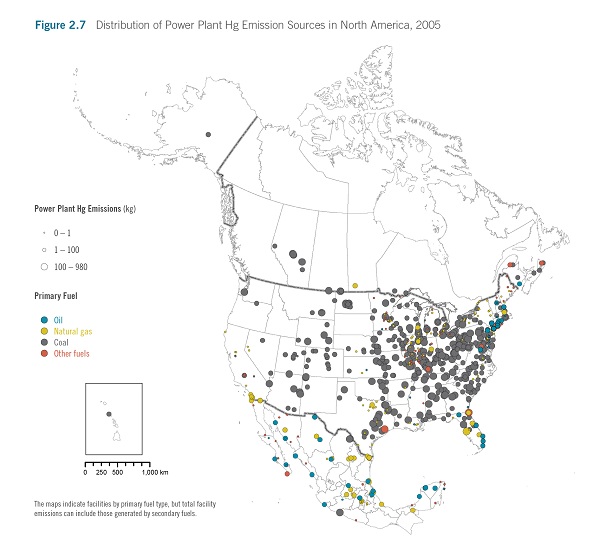Mercury (Hg)
For 2005, only 25 of the 189 power plants reported Hg emissions data in Canada, for a total of 2,079 kg; and 13 of these plants accounted for 90% of the total. Twenty of the 25 reporting facilities were coal-fired. According to the NPRI [41], coal-fired electric power generation was the largest single-remaining man-made source of mercury emissions in Canada in 2005.
Therefore, the Canadian Council of Ministers of the Environment (CCME) agreed to set Canada-wide Standards (CWS) for mercury emissions from coal-fired electric power plants, with the goal of reducing mercury emissions from existing plants (a capture of 60% of mercury in combusted coal by 2010) [42], and ensuring that new plants achieve emissions levels based on best available technologies economically achievable, or the equivalent.
Mercury emission rates for these 25 power plants ranged from 0.00146 to 0.0759 kg/GW-h, with the exception of the Grand Lake facility in New Brunswick, which had an emission rate of 0.3225 kg/GW-h for 2005. The emission rate obtained for this plant during the analysis carried out for the development of Canada-wide Standards (CWS) for mercury emissions in October 2003 was 0.2858 kg/GW-h, although there was a mercury mass imbalance of 16% in excess with respect to the mercury input [43].
The high emission rates of this plant were attributed to the use of indigenous coal [42], which had a mercury content of 0.623 mg/kg (dry), whereas the average value of the other coals considered in the study was 0.072 mg/kg [43]. In 2002 this plant was scheduled for retirement by 2010 because of its high emissions of both SO2 and mercury [44].
The provinces with major power plant Hg emissions were Alberta, followed by Saskatchewan and Ontario, with the three contributing approximately 89% of Canada’s total emissions. The top 10 facilities, ranked by Hg emissions, accounted for 82% of the Hg emissions from the 25 Canadian power plants (Table 2.13).
In Mexico, the main Hg emitters were also coal-fired power stations. Of the total Hg emissions from all 102 Mexican power plants (2,285 kg), 87% were from the country’s three coal-fired power plants, and the rest (291 kg) were derived from oil, diesel and natural gas-fired power plants.
The mercury emission rates of the three coal-fired power plants ranged from 0.050 to 0.072 kg/GW-h. It is important to note that there was an important difference in the Hg emissions estimation methodology from the 2002 to the 2005 inventories: the emission factor used for the 2002 inventory was 8.59 lb/1012 BTU and it was changed to 16.0 lb/1012BTU for 2005. With a recalculated value of the 2002 Hg emissions, a reduction of nearly 7% (in Hg emissions) would be obtained from 2002 to 2005.
The top 10 facilities, ranked by Hg emissions, accounted for 94% of the emissions of that substance from all 102 Mexican power plants in 2005 (Table 2.14).
In 2005, 632 of the 2,728 power plants in the United States reported nearly 50,000 kg of Hg. These plants had similar emission rates, of less than 0.250 kg/GW-h (except for five plants whose rates ranged from 0.250–0.796 kg/GW-h). In general, emission rates of less than 1 kg/GW-h are considered normal for such power plants, given the fuels used and amounts of electricity generated.
However, four other plants had emission rates ranging from 1.5 to 229 kg/GW-h, and values this high should be regarded with some reservation. Of the 632 plants, 220 accounted for 90% of total Hg emissions, with amounts ranging from 60 to 977 kg. Coal-fired power plants accounted for 69.5% of the total number of mercury emitting plants, while natural gas and oil-fired power plants accounted for 17.7% and 12.8%, respectively.
The top 10 facilities, ranked by Hg emissions, accounted for 15% of the Hg emissions from these 632 US power plants (Table 2.15).

Figure 2.6 illustrates the contribution to total mercury (Hg) emissions of all the mercury-emitting power plants, by country. It shows that around 35% of the plants in the United States accounted for 90% of its total Hg emissions, while around 5% of the plants in Mexico and nearly 50% of the plants in Canada contributed 90% of each country’s Hg emissions.
The geographical distribution of the Hg sources in North America is shown in Figure 2.7. The size of the dots represents the scale of emissions and the color represents the type of primary fuel used. In Canada, mercury emissions from power plants appear to occur mainly in the southwest, with the largest Canadian emitters, all coal-fired power plants, in Alberta.
In Mexico, the three major Hg emitters are the coal-fired power stations located in the central-north and central-south regions, whereas there are smaller Hg emissions sources distributed across the whole country - mainly power plants burning oil or other fuels.
The largest concentrations of Hg emissions sources in the United States are in the eastern half of the country; and in a fringe crossing the country through the states of Arizona, New Mexico, Utah, Wyoming, Montana and North Dakota. There are only a few Hg emission spots visible in the West.


